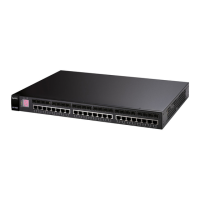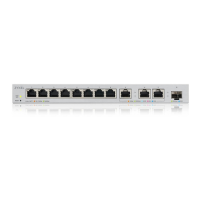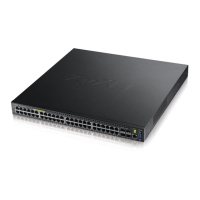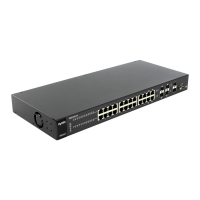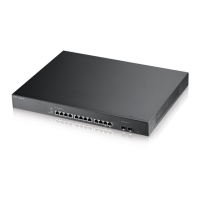Chapter 8 Basic Setting
XGS4600 Series User’s Guide
98
The following table describes the labels in this screen.
Table 22 Basic Setting > Port Setup
LABEL DESCRIPTION
SLOT This field appears only in stacking mode. Click the drop-down list to choose the slot number of
the Switch in a stack.
Port This is the port index number. In stacking mode, the first number represents the slot ID and the
second one is the port number. Please note that the default stacking ports (the last two ports of
your Switch) cannot be configured. They are reserved for stacking only.
* Settings in this row apply to all ports.
Use this row only if you want to make some settings the same for all ports. Use this row first to set
the common settings and then make adjustments on a port-by-port basis.
Note: Changes in this row are copied to all the ports as soon as you make them.
Active Select this check box to enable a port. The factory default for all ports is enabled. A port must
be enabled for data transmission to occur.
Name Type a descriptive name that identifies this port. You can enter up to 128 ASCII characters
except [ ? ], [ | ], [ ' ] or [ " ].
Note: Due to space limitations, the port name may be truncated in some Web
Configurator screens.
Speed/Duplex Select the speed and the duplex mode of the Ethernet connection on this port. Choices are
Auto, Auto-1G, 10-an (10M/auto-negotiation), 10M/Full Duplex, 100-an (100M/auto-
negotiation), 100M/Full Duplex, 1G/Full Duplex, and 10G/Full Duplex (Gigabit connections only).
Selecting Auto-1G or Auto (auto-negotiation) allows one port to negotiate with a peer port
automatically to obtain the connection speed and duplex mode that both ends support. When
auto-negotiation is turned on, a port on the Switch negotiates with the peer automatically to
determine the connection speed and duplex mode. If the peer port does not support auto-
negotiation or turns off this feature, the Switch determines the connection speed by detecting
the signal on the cable and using half duplex mode. When the Switch’s auto-negotiation is
turned off, a port uses the pre-configured speed and duplex mode when making a connection,
thus requiring you to make sure that the settings of the peer port are the same in order to
connect.
Flow Control A concentration of traffic on a port decreases port bandwidth and overflows buffer memory
causing packet discards and frame losses. Flow Control is used to regulate transmission of signals
to match the bandwidth of the receiving port.
The Switch uses IEEE 802.3x flow control in full duplex mode and backpressure flow control in half
duplex mode.
IEEE 802.3x flow control is used in full duplex mode to send a pause signal to the sending port,
causing it to temporarily stop sending signals when the receiving port memory buffers fill.
Back Pressure flow control is typically used in half duplex mode to send a "collision" signal to the
sending port (mimicking a state of packet collision) causing the sending port to temporarily stop
sending signals and resend later.
Select Tx Rx to allow the Switch port to send pause signal to the connected device, and for the
connected device to send a pause signal to the Switch. The Switch will temporarily stop sending
signals after receiving pause signal.
Select Tx to allow the Switch port to send pause signal to the connected device.
Select Rx to allow the connected device to send a pause signal to the Switch. The Switch will
temporarily stop sending signals.
Otherwise, select Disable.
802.1p Priority This priority value is added to incoming frames without a (802.1p) priority queue tag.
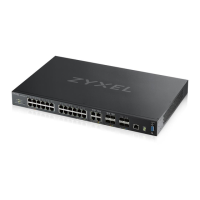
